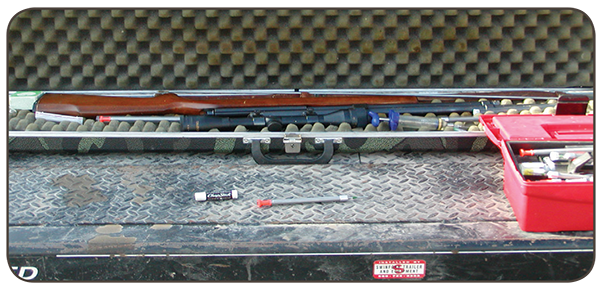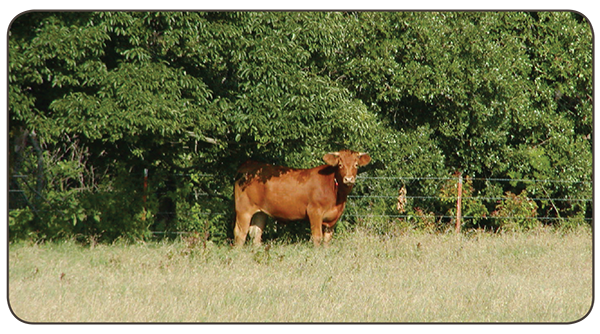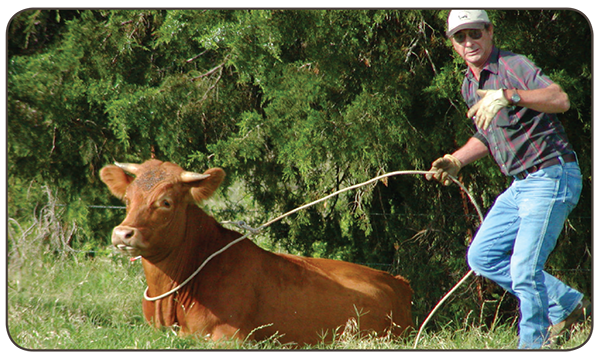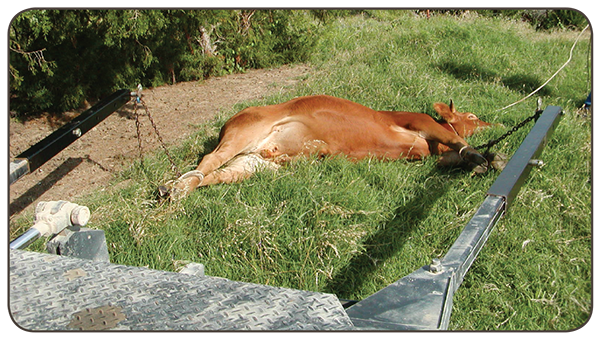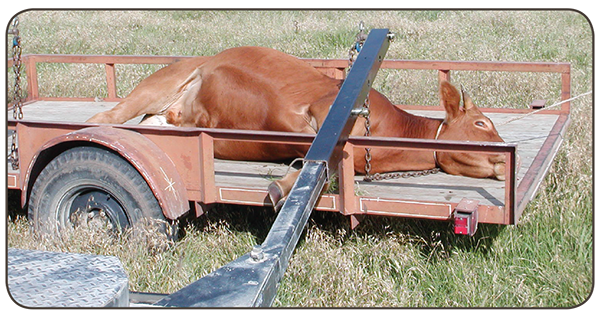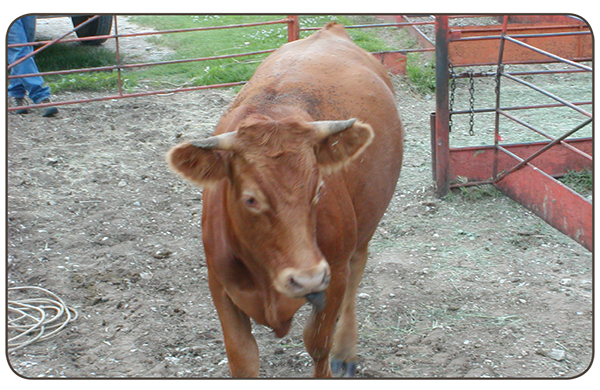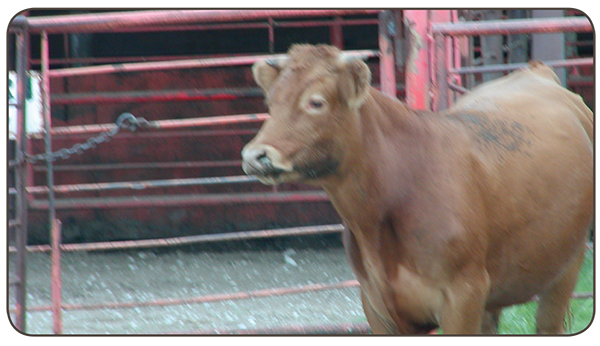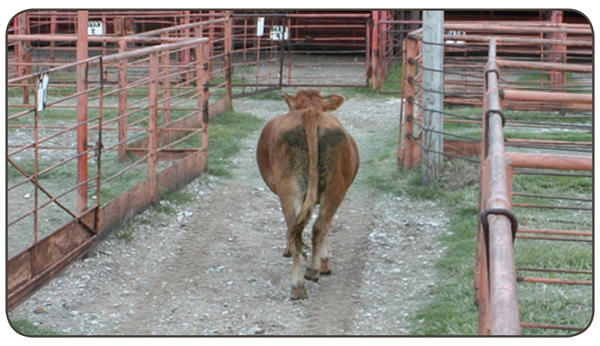
Pictorial Tranquilizing Sequence

I have chemically captured and transported many large animals over the years for various reasons. This pictorial story pretty much shows how things are supposed to go. A neighbor had sold his cattle through Superior Livestock via video auction some months prior. On this day he called me he was making delivery of the cattle, thus fulfilling his obligation of the contract. He had done a good job of obtaining a favorable price when he sold the cattle, and sure wanted to deliver every steer he was allowed.
His cattle were to be hauled 10 miles to the local sale barn to be weighed, and then the buyer of the cattle was to load them onto a “pot” and shipping them 350 miles north to the feedlot.
The owners of the sale barn had video-taped the cattle and were taking the delivery for the purchaser. They were assisting my neighbor at his farm load the cattle onto the gooseneck trailers for the 10 mile haul when they encountered the problem of one goofy steer. They all made it out of harm’s way as the crazy steer tried to “clean their clocks” , so to speak, and then jumped the chin tall steel fence. The steer didn’t stop at that. He wasn’t satisfied until he was back in the pasture he had come from, and created a couple of “fence fixing” jobs getting there.
The neighbor lucked out when he reached me that morning, for a guy that had been helping me process some of my replacement cattle was with me. It is a must to have some good help when you tranquilizing and transporting a large animal, so with the neighbor included there were three of us on hand to accomplish the task.
I received his call just after the last steer of the last trailer load was leaving his place. My neighbor really didn’t want to leave a crazy 850 pound steer alone in the pasture and have to look forward of dealing with him later. If he did manage to get the steer trapped again and actually loaded for auction, the steer would bring at least a $100.00 less just because he would be sold as a wild single. There would be a substantial weight loss on top of that also.
It was turning out to be a good day for my neighbor and for me. I had the time, some help available, and had just recently purchased a new camera. I had always wanted some pictures of knocking down a wild bovine. My friend would have an unwanted problem disappear, and I could use the monetary fee I charged to help pay for my camera. My dart gun had paid for itself a long time before this day. “I don’t knock down cattle just for fun just because it is”.
Here’s the actual process we used that day which turned what could have been a very difficult, dangerous, and time consuming job into a safer way that took less than one hour.
This picture was taken of the first step in preparation to capture the animal. His weight had been estimated at 850 pounds. The appropriate amount of drug was loaded into the dart, and the dart was loaded into the projector as well as the clip of blanks. We put the dart gun in the cab, temporarily stowed the remaining gear, and went to find the steer.
The bed on this truck was designed to load and unroll round bales of hay and was capable of lifting a ton. It would be utilized to lift and load the steer once we had him down and secured with ropes.
My helper was to follow me in my other feed truck that had a twelve by eight foot tilting flat-bed trailer attached to the bumper that the steer would be loaded onto. I told my helper Bobby, that once we arrived at the back pasture to where the steer was located, to stop and park the rig while my neighbor and I continued on in my feed truck to find and dart the steer. We traveled about a quarter of a mile over a hill when we discovered the steer under a tree that was next to an adjoining fence. I took this next photo just after implanting the dart into the steer’s neck.
Since the projector had been prepared beforehand, all that was required was to work the bolt of the rifle to chamber the green blank and properly adjust the power control setting as we rolled to a stop 30 yards from the steer. The injection didn’t bother the steer too much. He just stood there and turned his head toward us to see what was going on as I snapped the photo. Immediately after the photo we drove back over the hill to Bobby.
Upon our return to the other truck we were out of the line of sight and ear shot of the yearling. It was a good time and place to ready the gear to be used to secure and load him with. The first step was to attach “extension arms” to the hydro-bed. I had made these arms up several tranquilized animals prior to this episode. I had discovered that when I tried to lift a ton bull into the air to place it on the trailer, there was a significant amount of lack in elevation. That damn bull was extremely hard to get onto the trailer as the bulk of his body was against the back end of the truck bed. (Another one of my hard learned lessons)
It took about ten minutes to attach the extensions and ready the ropes, chains, and cargo straps. I made sure everyone had leather gloves to avoid the possibility of a rope burn, at least on their hands, as well as putting a very sharp knife on by belt in the event someone became tangled in a rope and urgently needed loose. The most import thing in doing this type of work is to keep all the people involved as safe as possible. The next most important thing is to take care of the animal. The time lapse from injection was around 15 minutes at this point, which should be just about the right amount of drug induction time for the drug I used.
When we neared the animal at 40 yards, I helped Bobby unhook the trail from the truck, but had him stay in the truck, with the motor running. In the event I needed something bigger than the steer to take a rope dally on in order to secure the steer, Bobby could rapidly close that distance. It was now show time! Here is a photo of what the steer was doing as we were unhooking the flatbed trailer. I was pleased with the “zoom” on my new camera!
From the forty yard location I began my approach with lariat in hand. The closer I got to the steer, the slower and quieter I became. I always approach a downed animal from behind. I successfully placed the loop of the around the steers neck.
My neighbor had neglected to dehorn this steer back when it was only weighing 450 pounds as he preformed the initial processing if his stocker cattle. I wanted to position the lariat on the steer’s neck as opposed to just his horns. By doing this, in the event the steer got to his feet, I could choke him back down and maintain control of him. Cattle have individual metabolisms just like people do. Drug requirements for heavy sedation can vary from individual to individual, as some are more anxious than others. As an example, I’ve seen some people take a sip of whisky and become looped. I’ve seen others drink a half of fifth and behave pretty much normal. Through experience you should become knowledgeable enough to be able to “read” the animal and come close to choosing the proper amount of drug required for the task.
As you will see in the next photo, this steer did become aroused, and managed to get to its feet. At this point I became a little excited myself and shouted to Bobby, “stop taking photos and get his butt over here! “ I could just see myself belly surfing across the pasture while holding on to the end of the lariat and finding every rock on the place!
As it worked out, I managed to flip the loop from the rear of the steer’s neck up towards the throat area just behind his head, and it took little effort to choke the steer back to the ground by hand. Bobby arrived in a timely fashion and I would have been able to get the loose end of the rope hooked to the truck should that had been necessary. Since I had the steer flattened out, Bobby jump out of the truck and helped me tie the back legs together first, and then the front legs.
As Bobby went back to the trailer and hooked it on, I positioned my truck to load the steer.
We had loosened the rope on the steer’s throat earlier to allow it to get air. The steer had a moment of awareness as we place him on the trailer, and was struggling a little bit in an attempt to get loose. Bobby was holding the loose end of the lariat as I positioned the steer onto the trailer. He didn’t want to wrestle this thing anymore than I did, so he shut off some of the steer’s air off until the steer calmed down as you can see in the next photo. We loosened the noose again when he started behaving himself.
The next step was to secure the steer for the ride to the sale barn. I would sure hate for the steer to get loose while going through town on the way. I could just see him going through the plate glass windows of the stores.
We put two ratcheting cargo straps over the steer. One was placed across the steer’s shoulder and the other one was placed across his hind quarters. You don’t want to restrict the animal’s respiratory system. The Xylazine was taking care of that already. We did leave the rope loosely around the steer’s neck, and had it tied to the trailer. … just in case!
What does not appear in any of the photos is the eye covering that was placed on the steer as soon as we were through securing the beast. A tranquilized animal might be asleep, but its eyes will remain open. If the eyes are exposed to the direct sunlight the retinas will be burned, and you could end up with a blind critter.
As soon as I was confident we could make the ten mile trip and arrive with the steer still secured, it was a against time with the steer laid out on its side. You don’t want bloat to kill him. Bobby was driving the truck with the trailer. I asked him to go as fast as the law would allow.
Upon arriving at the sale barn, the trailer was backed through a gate into an alley to unload. The pin was removed from the front of the trailer; the rope was move from the neck to around the steer’s horns and tied taut to the bottom of a post. By simply driving forward, the steer slid off onto the ground. I didn’t want to choke and further the steer anymore by leaving the rope on his neck at this point.
Had the steer not had horns I would have used a chain around the neck, and hooked the “pull off chain” on the bottom side of the throat, and under his cheeks. If this method had to be employed to pull and animal off the trailer, the pressure would be on the back of its head and not on its throat.
Untie the animal’s legs before injecting the antagonist. You won’t want to be doing this when it is awake!
When administering the recovery drug you will want to be in the jugular vein with you needle and use a pumping motion with the hand syringe plunger. Blood should be drawn back into the syringe to mix with the drug, and be repeated throughout the procedure slowly, until all the contents of the syringe are in the animal.
After you pull your needle out of the vein, it’s a good idea to get yourself out of the way. In this case I immediately grabbed the steer’s horn and assisted him to the sternum position on my way to the gate.
By the time I got through the gate and latched it, Old Crazy was up to his hooves.
Within a minute of administering the Tolozine, his disposition was returning to normal.
The sale barn people had a little trouble with him once he neared the scales, as he was somewhat reluctant to step across the crack of the moving platform and turned on them. They did manage however, the steer’s weight was caught, and he was returned with the rest of the herd, loaded, and headed north. EVERYONE was glad to see him go!


